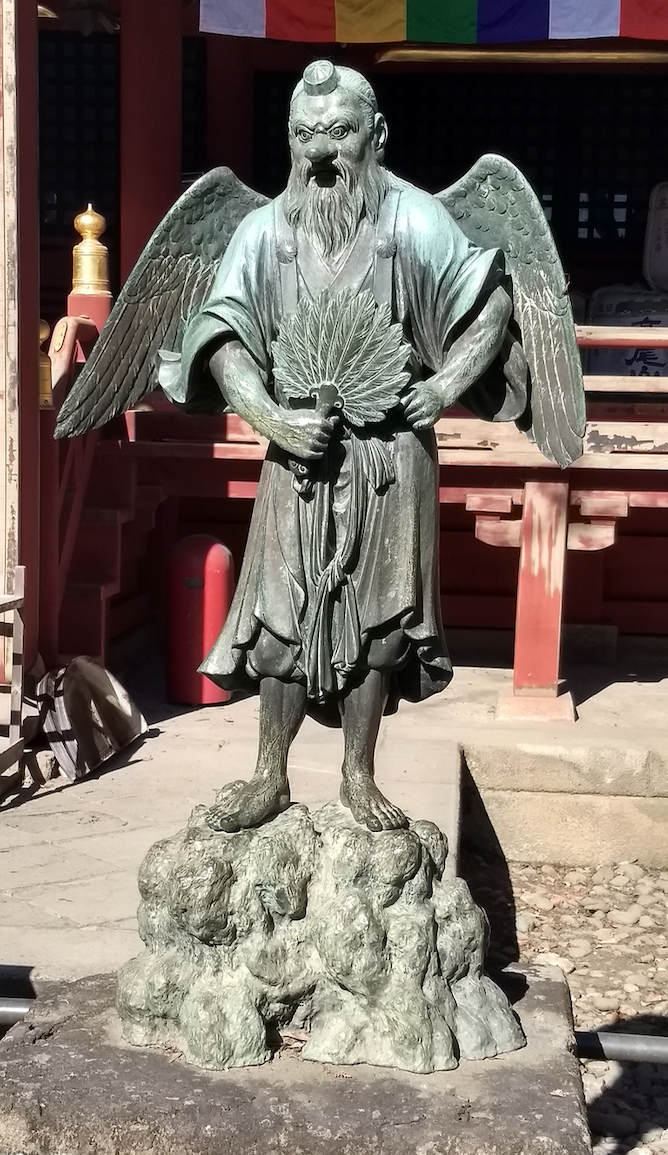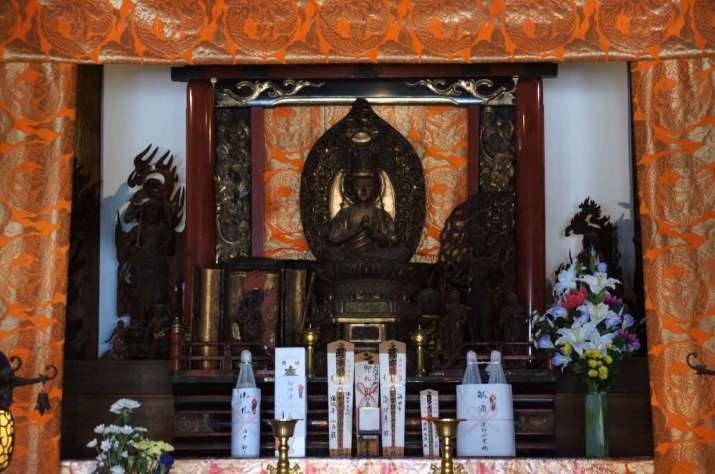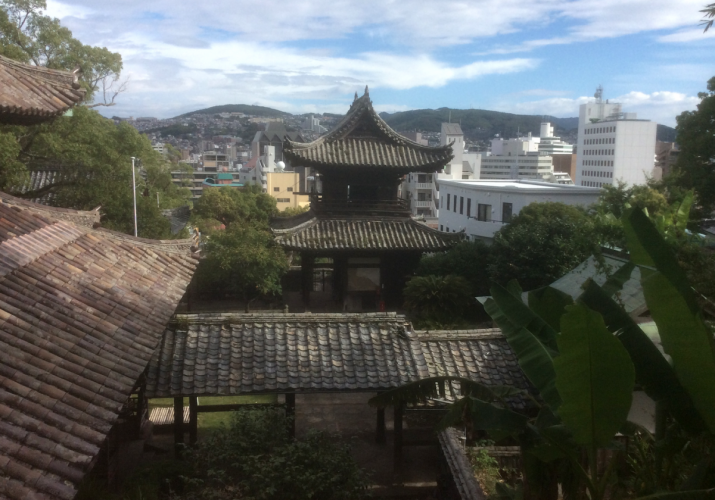FEATURES|COLUMNS|Buddhism in Japan
Japanese Buddhism 101: The Search for the Buddha

Statue of a Tengu, a forest spirit, at Yakuō-in on Mt. Takao
(Hachiōji, Tokyo), where Shingon Buddhism and Shintō unite.
Photo by the author
In 1977, Ronald Eyre released the “Japanese Buddhism” installment of his documentary series The Long Search, titled Land of the Disappearing Buddha. This film is designed to introduce various forms of Buddhism in Japan to the anglophone audience of the late 1970s. While it succeeds in providing such an introduction, albeit a rather romanticized one, to some degree the title of the film is rather misleading. Eyre’s main point seems to be that it is difficult to find in Japan forms of Buddhism presented in the Pali Canon or practiced today in South and Southeast Asia. The title of his film also seems to echo Zen sayings such as the famous “kill the buddhas and the ancestors” (Jap: satsubutsu satsuso) (T 1997.47.792a09) and “when you see a buddha, kill that buddha; when you see an ancestor, kill that ancestor” (Jap: kenbutsu satsubutsu kenzo satsuso) (T 1999.47.979b23, T 2000.47.1041b25-26). However, and this is important to note, “Buddha” is not absent in Japan; on the contrary, descriptions and images of—as well as devotion to—a multiplicity of buddhas (including the Buddha himself) can be easily found. In this essay, I will introduce some images of, and forms of, devotion to various buddhas in Japan.
One of the tropes circulated about Buddhism in Japan is its division into many different schools. This “sectarian nature” of Japanese Buddhism is sometimes juxtaposed with the seeming unity or uniformity of, especially, Korean and Chinese Buddhism. And it is true that in Japan one finds a variety of institutionalized Buddhist schools. However, this rhetoric overlooks that Buddhism everywhere is diverse, manifesting itself in a variety of movements, traditions, schools, lineages, practices, and forms of devotion. At the same time, despite the sectarian rhetoric in Japan, there are quite a few features (such as the nationwide danka, parish, system which assigns Buddhists to an ancestral temple) and practices common to the various schools of Buddhism in Japan.
The Heart Sūtra (Skt: Prajñāpāramitā-hṛdaya-sūtra, Jap: Shingyō) plays a significant liturgical and emotional role in most forms of Buddhism in Japan. In addition, sūtras and iconography, but also practices and beliefs are shared and not limited to specific schools or traditions. For example, the Shikoku pilgrimage (Jap: Shikoku hachijū hakkasho reijō)* in honor of Kūkai (commonly known by his posthumous name Kōbō Daishi), ostensibly a practice sanctioned and institutionalized by Shingon Buddhism, entails temples affiliated with Tendai Buddhism, Rinzai Zen, and Sōtō Zen as well. It is also not uncommon that a practitioner, whose family is affiliated with the temple of one school, has chosen a practice from, and is associated with, a temple of another. In addition, some temples offer practices that are seemingly at odds with the main doctrine of the school with which they are affiliated.** In the remaining sections, I will present a variety of religious systems central to Japanese Buddhism and identify the schools with which they are traditionally (but not exclusively) associated.
The overwhelming majority of the Buddhist schools in Japan belong to Mahāyāna (and/or Vajrayāna) Buddhism and privilege Mahāyāna Buddhist scriptures, imagery, philosophy, and soteriology. The schools inherit and disclose the wide variety in scriptures, practices, and forms of devotion that can be found in Mahāyāna Buddhism in general. One admittedly imperfect strategy to categorize the various religious systems found in the Buddhist schools in Japan is to differentiate them by practice as devotional (Nichiren, Pure Land, and True Pure Land), esoteric (Tendai and Shingon), and contemplative (Rinzai, Sōtō, and Ōbaku Zen) forms of Buddhism. However, before I continue, I need to add a disclaimer: most forms of Buddhism in Japan practice some sort of devotion as well as contemplation, and the esoteric school of Tendai Buddhism claims to promote all traditional Buddhist practices conceivable. Ultimately the identifying mark used to categorize the various religious systems is to be found in the rhetoric of the respective schools rather than their concrete practice.
 The altar of Kaikō-ji (Sakata, Yamagata) featuring the cosmic Mahāvairocana. According to the priestess of Kaikō-ji, the other form is Amaterasu. Photo by the author
The altar of Kaikō-ji (Sakata, Yamagata) featuring the cosmic Mahāvairocana. According to the priestess of Kaikō-ji, the other form is Amaterasu. Photo by the authorNichiren Buddhism presents itself as a single-Buddha (Shakyamuni), single-scripture (Lotus Sūtra), and single-practice (daimoku) form of Buddhism. It is believed that the recitation of the name of the Lotus Sūtra, “namu myōhō rengekyō,” allows the practitioner to attain “supreme perfected enlightenment” (Skt: anuttarā samyak saṃbodhi) and “opens the practitioner to the experience of mystic identification with ultimate reality” (Habito 2019, 458) during which the Lotus realm is embodied.
The various forms of Pure Land Buddhism emphasize devotion to Amida Buddha and the practice of chanting his name called nenbutsu. Pure Land thought is based on the so-called three Pure Land sūtras, the Immeasurable Life Sūtra (Chin: Wulianhshou jing), the Amida Sūtra (Chin: Amituo jing), and the Pure Land Sūtra (Chn: Jingtu lun). Trust in Amida expressed by the recitation of his name, “namu amida butsu” will result in “birth” (Jap: ōjō) in the Pure Land and, according to the later Shinran (1173–1263), the founder of True Pure Land Buddhism (Jap.: shinshū), ultimately, a “return” (Jap: kansō) to saṃsāra in a function not unlike that of a bodhisattva.
The three Zen schools ostensibly claim to be no-scripture schools—one of the Zen maxims promulgated ironically in the Zen canon is “do not rely on scriptures and words” (Jap: furitsu monji) (T 2005.48.293c15)—and to interpret the figure and trope of the “Buddha” as a symbol for the “buddha-nature” (Skt: tathāgatagarbha, Jap: busshō) that is in all of us and that has to be recognized in kōan meditation (in Rinzai), actualized in “sitting meditation” (Jap: zazen) (in Sōtō), or evoked in “nenbutsu meditation” (Jap: nenbutsu zen) (in Ōbaku), respectively.
Tendai Buddhism, which privileges Shakyamuni Buddha and the Lotus Sūtra, but has an appreciation for the Mahāyāna canon at large and encourages the veneration of a plethora of buddhas and bodhisattvas, maintains that we can attain buddhahood in this or a succeeding life through rigorous training that includes all of the above-mentioned Buddhist, as well as select Shintō, practices such as the “waterfall practice” (Jap: misogi). Finally, Shingon Buddhists believe that the practice of the “three mysteries” (Jap: sanmitsu) that purify body, speech, and mind through mudra, mantra, and mandala practices enables the practitioner to “become a buddha in this present body” (Jap: sokushin jōbutsu) and to embody the “Sun Buddha” (Skt: Mahāvairocana) and/or one of his many manifestations.*
 Shōfukuji in Nagasaki is one of the few Ōbaku Zen temples in Japan. Photo by the author
Shōfukuji in Nagasaki is one of the few Ōbaku Zen temples in Japan. Photo by the authorWhile this extremely short discussion of doctrinal Buddhist beliefs and practices in Japan may seem unsatisfactory in some sense, it does bring to the fore one of the central maxims of Mahāyāna Buddhism, namely that “one-is-also-all” (Jap: issokuta). To me, these practices exemplify the teaching that provides the key to Buddhism as well as to religious practice: Buddha’s teaching (Skt: Dharma) is expressed in multiple ways: there are many roads to the spiritual core of what it means to be human; Buddha can be found even in the most unexpected places.
* Walking with Kukai–Becoming a Buddha: Pilgrimage in Shingon Buddhism (Buddhistdoor Global)
** How to Face Death: Pilgrimage and Death Rituals in Japanese Buddhism (Buddhistdoor Global)
References
Habito, Ruben. 2019. “Lotus Land in This Very Body: The Religious Philosophy of Nichiren,” in Dao Companion to Japanese Buddhist Philosophy, ed. Gereon Kopf, pp. 451-470. Dordrecht: Springer.
Takakusu, Junjirō and Kaigyoku Watanabe, eds. 1961. Taishō Taizōkyō (The Taishō Edition of the Buddhist Canon). Tokyo: TaishōShinshū Daizōkyō Kankōkai. [Abbr. T].
Related features from Buddhistdoor Global
Can Rebirth in the Pure Land Be Attained by Reciting the Names of Buddhas Other than Amitabha? (Part One)
Nine Qualities of the Buddha
Who Is the Buddha?














